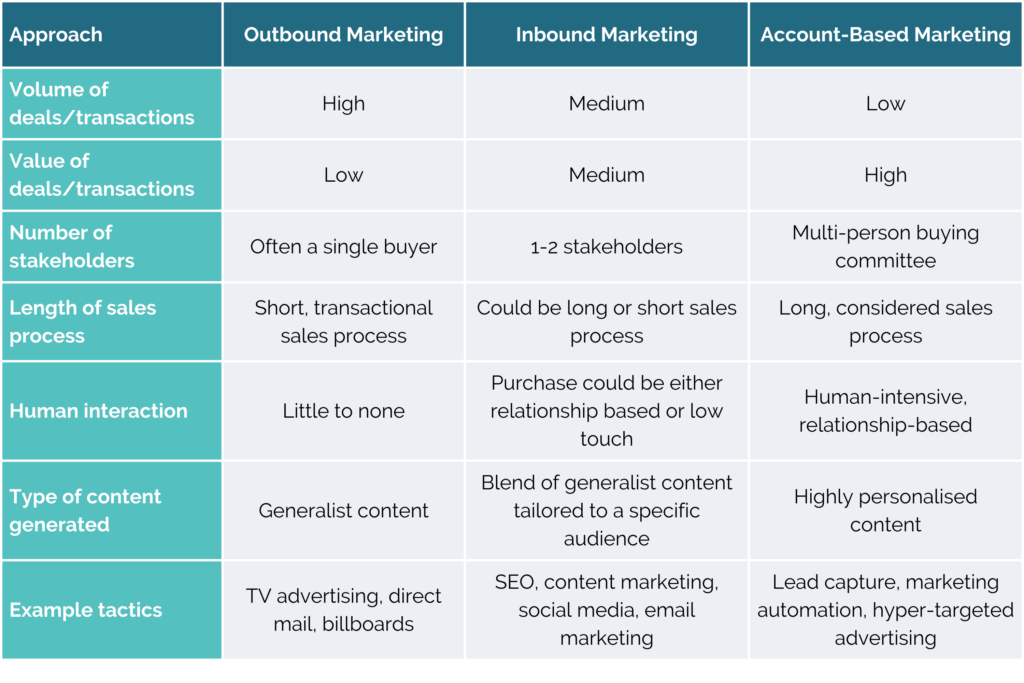
It’s possible you’ve heard about account-based marketing (ABM) by now, because it’s getting a lot of attention in the world of B2B marketing.
“ABM offers organisations a much greater return on their investment compared with traditional digital marketing!”
“ABM starts more conversations and closes more deals!”
“ABM flips the B2B sales and marketing funnel on its head!”
Sounds pretty great, doesn’t it?
Of course, at this stage you might be asking yourself a valid question: “What the hell is account-based marketing?”
Account-based marketing definition
Account-based marketing (ABM) is a strategic approach to B2B marketing in which marketing and sales teams target ‘best-fit’ prospects. This involves creating targeted messaging that speaks directly to the goals and objectives of the companies — and those companies’ stakeholders — you want to turn into customers.
This differs from traditional digital marketing where you target generalised buyer personas with broader messaging.
ABM tactics can also be used for marketing to existing customers to encourage upselling and cross-selling, ensuring you generate the most value from your accounts.
Check out the below table to see how ABM compares with Outbound and Inbound marketing.

Which industries are Account-based Marketing campaigns most suited to?
Account-based marketing is a strategic marketing approach that works exclusively for B2B industries, but does it work for all B2B organisations?
Although there’s no specific B2B industry that ABM is best suited to, it does work for some types of companies better than others.
Companies that are solving problems for their customers
All products and services solve a challenge for an individual or organisation, but the solutions for some problems aren’t as obvious as others, and require a bit of education.
Whether your target accounts have industry-specific, role-specific or business-growth challenges, ABM campaigns are ideal for situations where stakeholders need to be educated on the benefits of your solution. This is because you’ve already identified their main challenges during the prospecting phase, and created tailored content around solving them.
You’re working with larger deal sizes
ABM requires a significant investment of time and resources to be effective, and this means you need to see a high ROI.
If your products are priced below £100 for example, it’s unlikely an ABM campaign is going to generate enough revenue to be profitable. After all, you’re creating tailored content for specific target accounts, and this isn’t something you can do quickly or at scale.
You’re working with longer sales cycles
Following on from the deal size point, ABM campaigns are also better suited to products or services that require longer sales cycles.
If all it takes is a single advert and landing page to generate a sale you don’t need to spend time creating personalised content.
Your buyers have multiple stakeholders
ABM is typically a good fit for B2B companies that have multiple stakeholders involved in any purchase decision. For example, if you’re selling a comprehensive software solution you might be targeting the IT Director, the CFO and the CEO all with different messages.
It’s very difficult to target all of these people effectively with a single message, but with an ABM approach you can create tailored messaging for each stakeholder that’s specific to their unique challenges.
How to effectively implement ABM
There are five key steps for effectively implementing account-based marketing:
Step 1: Define your strategic accounts
Here at Aira, we have a few predefined buyer personas. However, these are not examples of strategic accounts.
Instead of defining types of people that make up your target audience, you need to define specific types of companies — your ideal customer profile.
Your ideal customer profile should represent the accounts that generate the most revenue for your business, as well as other desirable criteria. The completed profile(s) will typically include elements such as annual turnover, company size, industry and location, and will rely on both qualitative and quantitative research.
Step 2: Identify your target accounts
Once you’ve defined your ideal customer profile you need to create a long list of target accounts that fit this profile, before digging deeper into these companies to identify factors such as:
- Who are the key decision makers at these accounts?
- What does the decision making process look like?
- Do they already have a supplier/provider for the products or services you offer?
At this stage, you’ll also want to think about the type of ABM campaigns you’ll be executing. There are three types of account-based marketing approaches:
- One-to-one, (sometimes known as Strategic ABM)
- One-to-few, (sometimes known as ABM Lite)
- One-to-many, (sometimes known as Programmatic ABM)
One-to-one
One-to-one ABM is typically focused on less than 10 accounts, with hyper-targeted and highly customised messaging that is solely relevant to that business and that business alone.
One-to-few
One-to-few is an approach suitable for anywhere between 10 and 50 accounts, where content is still personlised, but can be reproduced and tweaked slightly for its intended recipient, assuming the accounts have similar challenges and objectives.
One-to-many
One-to-many is designed for an entire group of accounts (50-1000) and involves targeting a wider audience with content that isn’t as personalised, but still more tailored than ‘broad reach’ marketing.
The content collateral required for these campaigns is typically repurposed, rather than created specifically for certain accounts.
Step 3: Create personalised campaigns
Now you know who your target accounts are and what makes them tick, you can start creating content and messaging that’s personalised to those target accounts and the stakeholders you need to get in front of.
To create ABM content that’s going to be effective you need to align marketing and sales teams. Your sales teams will be heavily involved in making sure your ABM campaigns are a success, so they need to be bought into the messaging they’re going to be using when reaching out to prospects.
During step two you’ll have identified which channels are best for reaching the key stakeholders at your target accounts, and this will also be a factor when creating these marketing campaigns.
Step 4: Execute your ABM campaign
When executing traditional digital campaigns it’s all about maximising (relevant) reach, increasing traffic and generating inbound leads. This can lead to a bit of a more-is-more approach to frequency of content.
However, keep in mind that ABM is a much more targeted approach. Make sure you don’t bombard your target accounts with repeated messages across multiple channels, or overdo it remarketing on specific channels.
Also remember that you’re not just targeting one or two buyer personas at your target organisations, but multiple key stakeholders within the organisation — so bear this in mind when setting up your targeting.
Step 5: Measure the results
As with all marketing campaigns, make sure you constantly measure the results of your ABM campaigns and optimise appropriately.
Measuring the success of ABM campaigns isn’t exactly the same as traditional digital marketing campaigns. After all, you don’t necessarily care about impression numbers, web page visits or total form submissions.
Instead, consider the following:
- Are the key stakeholders positively engaging with the personalised content you’re creating?
- Are these stakeholders progressing down the funnel following engagement with the content?
- Is the target account becoming more engaged with your brand as a whole?
- Has the campaign generated direct or influenced revenue?
Note that the nature of ABM campaigns makes it hard to run effective A/B, multivariate or other tests, because the content should be tailored to each target account. However, that doesn’t mean you can’t identify what marketing assets are working or not working and iterate based on those results.
Implementing an ABM approach can deliver more sales and increase revenue, but it’s not right for every organisation. If you’re not sure whether or not to take the ABM plunge, drop us a message here, or feel free to give us a call. We’ll be honest with you about whether or not it’s the right strategy for your business and what you want to achieve, and advise on what you should be doing.




